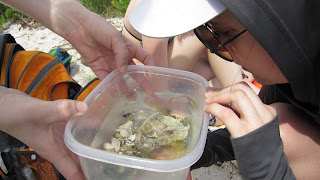It was the second day at the Archbold Research Facility. We started off the day going to Lake Annie, hoping to see an alligator. Unfortunately we didn't find one, but we did find a lot of orb weaver spiders and a lot of spiders in the brush around the lake. Just as Pete got into the water and Emily was thinking about going in, we all got in the van to see the tortoise site. We got to see a lot of burrows and a tortoise. The researchers are continuing a study that was set up in 1967 to see how long the tortoises live. They showed us a scope that is designed to go into the burrows to find the tortoise and see how long the burrow is. After lunch we met with Mark the entomologist at Archbold who told us a lot about the bugs in Florida, and how intricate their ecology is. After dinner we got geared up to go hunt for wolf spiders. We collected a lot and gave Sky some for her neurological research.
An orb-weaver spider we found at Lake Annie.
Tortoise number 800 at the tortoise research site.
A brown widow spider that was found at Lake Annie.
Everyone is ready to go hunt wolf spiders.
Rachel conquers her fear of spiders.
Jessica is intrigued by the large wolf spider.
Emily shows off what she found hiding in the bushes.
Maria, unsure about the spiders at first, decides to give it a try.
Brandon finds his true love.
Ayla and Pete have no problem handling the spiders.
Dana finds a tick to add to our list of invertebrates.








































